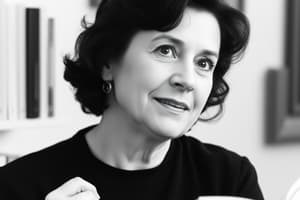Podcast
Questions and Answers
What does the lack of capitalisation on the first word of the stanza suggest?
What does the lack of capitalisation on the first word of the stanza suggest?
- It signifies the start of a new theme.
- It emphasises the importance of the first word.
- It indicates the end of a sentence.
- It hints that the reader is entering mid-sentence. (correct)
Which literary device is used to reflect the sense of indifference from the doctor regarding the woman's infertility?
Which literary device is used to reflect the sense of indifference from the doctor regarding the woman's infertility?
- Alliteration
- Personification
- Juxtaposition (correct)
- Hyperbole
What imagery is used to convey the dire state of the Irish people in the text?
What imagery is used to convey the dire state of the Irish people in the text?
- Growing gardens.
- Bones seen from a carriage window. (correct)
- Voices reaching out.
- Snowflakes settling and melting.
How does the speaker portray the perspective of the previously voiceless woman in the final stanza?
How does the speaker portray the perspective of the previously voiceless woman in the final stanza?
What effect does the enjambment have in the stanza focusing on the ‘typhoid pariah’?
What effect does the enjambment have in the stanza focusing on the ‘typhoid pariah’?
Flashcards
Irish Famine
Irish Famine
A period of widespread starvation and hardship in Ireland during the 1840s.
Female Infertility
Female Infertility
Inability to conceive a child, often related to health conditions or societal pressures.
Subjugation
Subjugation
The act of bringing someone under control.
Colonial Attitude
Colonial Attitude
Signup and view all the flashcards
Twin Narratives
Twin Narratives
Signup and view all the flashcards
Poetic Devices
Poetic Devices
Signup and view all the flashcards
Power Dynamics
Power Dynamics
Signup and view all the flashcards
Imagery of suffering
Imagery of suffering
Signup and view all the flashcards
Futility of Religion
Futility of Religion
Signup and view all the flashcards
Human Dehumanization
Human Dehumanization
Signup and view all the flashcards
Study Notes
Famine and Female Experience
- Combines narratives of the Irish famine and female infertility.
- Illustrates the mistreatment of the Irish people during the famine era.
- Explores themes of subjugation, control, suffering, and silence in both historical and personal contexts.
Key Themes
- Strong condemnation of the famine's impact on Ireland.
- Highlights the loneliness of the female experience amidst societal struggles.
- Commemorates Irish history while reflecting on the horrors of the famine.
- Considers dynamics of power, particularly the authority over the oppressed.
Poetic Style
- Employs twin narratives to present dual experiences.
- Utilizes rhyming couplets and slant rhyme to create rhythm and euphony.
- Incorporates caesura for moments of reflection and enjambment to depict apathy in power dynamics.
Stanza Analyses
- Opening Simile: Compares the Irish to lazy trout, introducing disdain for their plight.
- Trevelyan’s Role: Boland adopts his voice to criticize indifference towards the Irish suffering.
- Powerlessness in Infertility: The female character remains voiceless through clinical tones of authority figures.
Words of the Oppressor
- Visual and Syntax Choices: Lack of capitalization suggests abruptness and troubled thoughts; reflects a shifting focus.
- Personal vs. Impersonal: The juxtaposition of clinical detachment versus intimate personal struggles.
- Human dehumanization: The Irish are treated like commodities, reducing their dignity and humanity.
Imagery and Emotion
- Oppression and Suffering: The imagery reflects deeper themes of survival amidst dire conditions, hinting at cannibalism due to starvation.
- Death and Disease: The ‘typhoid pariah’ characterizes the despair of death and rejection by society, symbolizing the broader health crisis.
- Futility of Religion: Represents a godless landscape where faith offers no solace in suffering.
Dismissal of Femininity
- The female voice ultimately acknowledges her barrenness and equates her body to a "famine road," emphasizing emptiness and purposelessness.
- Last stanza evokes unity of both narratives—women’s struggle is intrinsically linked to Irish suffering.
Concluding Motifs
- Colonial Attitude: Self-congratulation of colonizers juxtaposed against the festering realities of the oppressed Irish.
- Repetition of “parish to parish, field to field”: Stresses the pervasive nature of suffering and the cycle of hardship.
- Final Imagery: Closes with the haunting metaphor of the woman's body, representative of both infertility and region’s devastation.
Studying That Suits You
Use AI to generate personalized quizzes and flashcards to suit your learning preferences.




